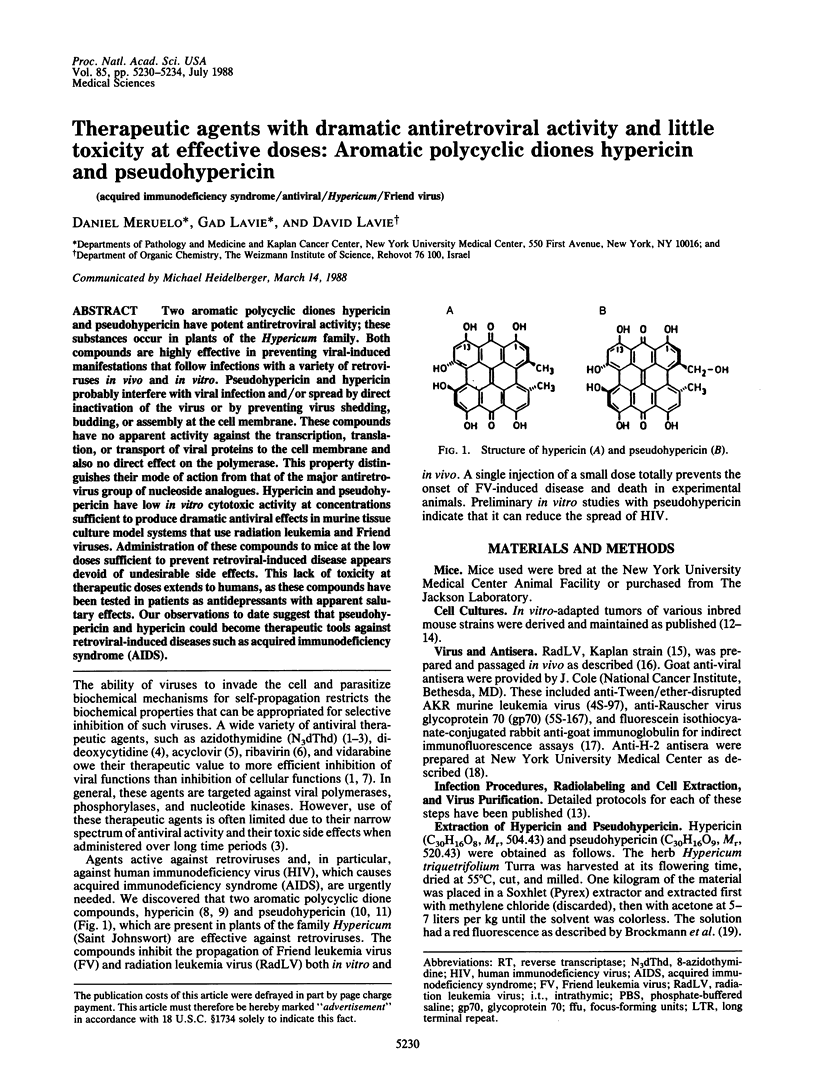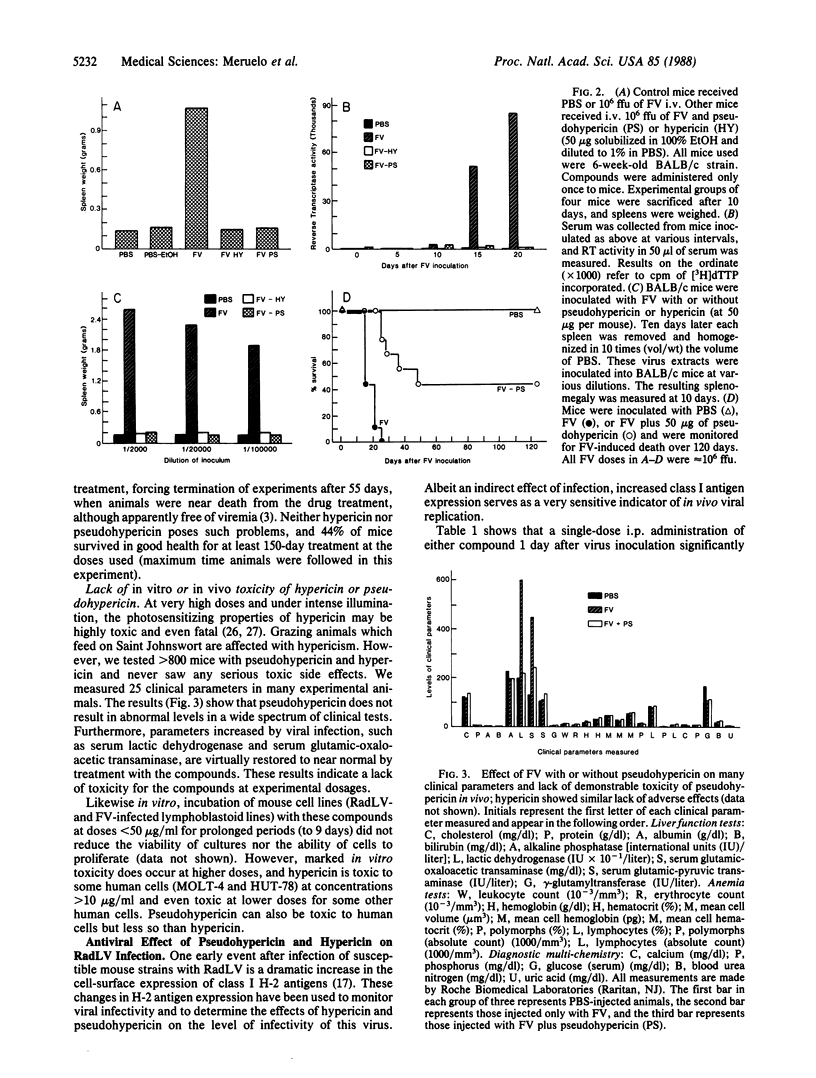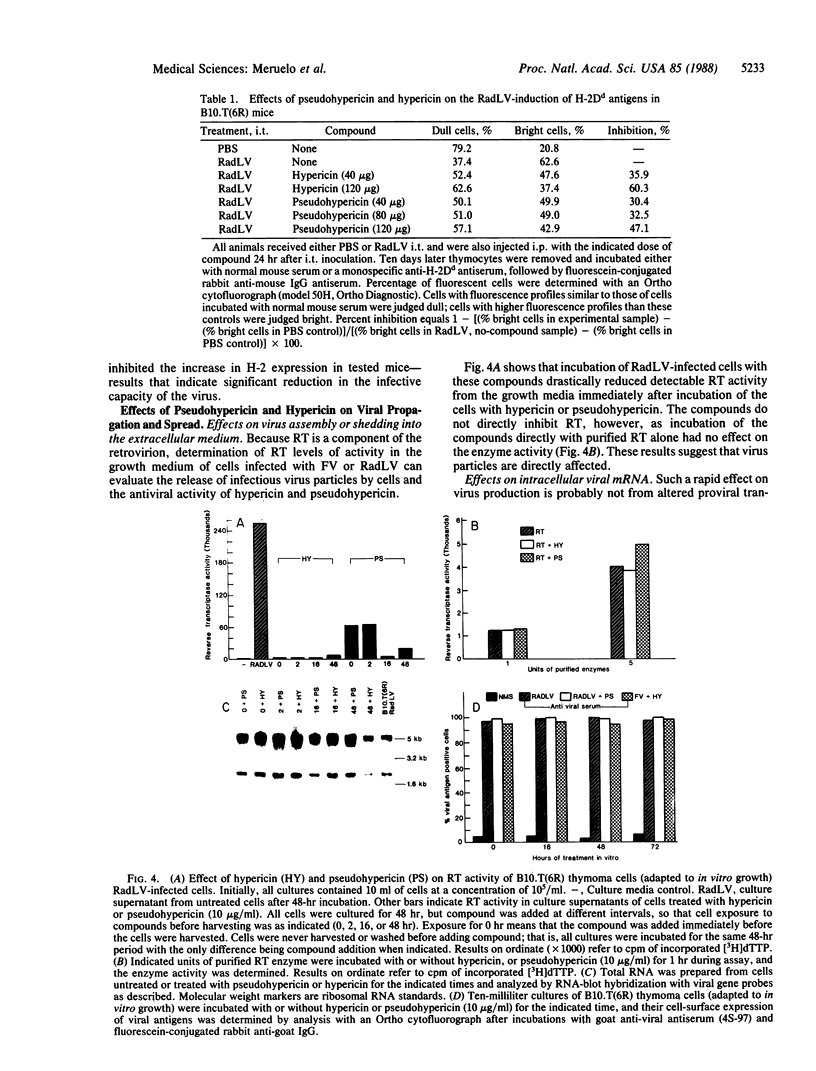Abstract
Two aromatic polycyclic diones hypericin and pseudohypericin have potent antiretroviral activity; these substances occur in plants of the Hypericum family. Both compounds are highly effective in preventing viral-induced manifestations that follow infections with a variety of retroviruses in vivo and in vitro. Pseudohypericin and hypericin probably interfere with viral infection and/or spread by direct inactivation of the virus or by preventing virus shedding, budding, or assembly at the cell membrane. These compounds have no apparent activity against the transcription, translation, or transport of viral proteins to the cell membrane and also no direct effect on the polymerase. This property distinguishes their mode of action from that of the major antiretro-virus group of nucleoside analogues. Hypericin and pseudohypericin have low in vitro cytotoxic activity at concentrations sufficient to produce dramatic antiviral effects in murine tissue culture model systems that use radiation leukemia and Friend viruses. Administration of these compounds to mice at the low doses sufficient to prevent retroviral-induced disease appears devoid of undesirable side effects. This lack of toxicity at therapeutic doses extends to humans, as these compounds have been tested in patients as antidepressants with apparent salutary effects. Our observations to date suggest that pseudohypericin and hypericin could become therapeutic tools against retroviral-induced diseases such as acquired immunodeficiency syndrome (AIDS).
Full text
PDF




Images in this article
Selected References
These references are in PubMed. This may not be the complete list of references from this article.
- Bach R. G., Meruelo D. Identification of a 36,000-molecular weight, gag-related phosphoprotein in lymphoma cells transformed by radiation leukemia virus. J Exp Med. 1984 Jul 1;160(1):270–285. doi: 10.1084/jem.160.1.270. [DOI] [PMC free article] [PubMed] [Google Scholar]
- Chattopadhyay S. K., Cloyd M. W., Linemeyer D. L., Lander M. R., Rands E., Lowy D. R. Cellular origin and role of mink cell focus-forming viruses in murine thymic lymphomas. Nature. 1982 Jan 7;295(5844):25–31. doi: 10.1038/295025a0. [DOI] [PubMed] [Google Scholar]
- Chesebro B., Wehrly K. Studies on the role of the host immune response in recovery from Friend virus leukemia. II. Cell-mediated immunity. J Exp Med. 1976 Jan 1;143(1):85–99. doi: 10.1084/jem.143.1.85. [DOI] [PMC free article] [PubMed] [Google Scholar]
- FRIEND C. Cell-free transmission in adult Swiss mice of a disease having the character of a leukemia. J Exp Med. 1957 Apr 1;105(4):307–318. doi: 10.1084/jem.105.4.307. [DOI] [PMC free article] [PubMed] [Google Scholar]
- LIEBERMAN M., KAPLAN H. S. Leukemogenic activity of filtrates from radiation-induced lymphoid tumors of mice. Science. 1959 Aug 14;130(3372):387–388. doi: 10.1126/science.130.3372.387. [DOI] [PubMed] [Google Scholar]
- Meruelo D. A role for elevated H-2 antigen expression in resistance to neoplasia caused by radiation-induced leukemia virus. Enhancement of effective tumor surveillance by killer lymphocytes. J Exp Med. 1979 Apr 1;149(4):898–909. doi: 10.1084/jem.149.4.898. [DOI] [PMC free article] [PubMed] [Google Scholar]
- Meruelo D., Kornreich R., Rossomando A., Pampeno C., Boral A., Silver J. L., Buxbaum J., Weiss E. H., Devlin J. J., Mellor A. L. Lack of class I H-2 antigens in cells transformed by radiation leukemia virus is associated with methylation and rearrangement of H-2 DNA. Proc Natl Acad Sci U S A. 1986 Jun;83(12):4504–4508. doi: 10.1073/pnas.83.12.4504. [DOI] [PMC free article] [PubMed] [Google Scholar]
- Meruelo D., Lieberman M., Deak B., McDevitt H. O. Genetic control of radiation leukemia virus-induced tumorigenesis II. Influence of Srlv-1, a locus not linked to H-2. J Exp Med. 1977 Oct 1;146(4):1088–1095. doi: 10.1084/jem.146.4.1088. [DOI] [PMC free article] [PubMed] [Google Scholar]
- Meruelo D., Nimelstein S. H., Jones P. P., Lieberman M., McDevitt H. O. Increased synthesis and expression of H-2 antigens on thymocytes as a result of radiation leukemia virus infection: a possible mechanism for H-2 linked control of virus-induced neoplasia. J Exp Med. 1978 Feb 1;147(2):470–487. doi: 10.1084/jem.147.2.470. [DOI] [PMC free article] [PubMed] [Google Scholar]
- Meruelo D., Paolino A., Flieger N., Dworkin J., Offer M., Hirayama N., Ovary Z. Functional properties of Ly 11.2 lymphocytes: a role for these cells in leukemia? J Immunol. 1980 Dec;125(6):2719–2726. [PubMed] [Google Scholar]
- Mitsuya H., Broder S. Inhibition of the in vitro infectivity and cytopathic effect of human T-lymphotrophic virus type III/lymphadenopathy-associated virus (HTLV-III/LAV) by 2',3'-dideoxynucleosides. Proc Natl Acad Sci U S A. 1986 Mar;83(6):1911–1915. doi: 10.1073/pnas.83.6.1911. [DOI] [PMC free article] [PubMed] [Google Scholar]
- Mitsuya H., Weinhold K. J., Furman P. A., St Clair M. H., Lehrman S. N., Gallo R. C., Bolognesi D., Barry D. W., Broder S. 3'-Azido-3'-deoxythymidine (BW A509U): an antiviral agent that inhibits the infectivity and cytopathic effect of human T-lymphotropic virus type III/lymphadenopathy-associated virus in vitro. Proc Natl Acad Sci U S A. 1985 Oct;82(20):7096–7100. doi: 10.1073/pnas.82.20.7096. [DOI] [PMC free article] [PubMed] [Google Scholar]
- Pampeno C. L., Meruelo D. Isolation of a retroviruslike sequence from the TL locus of the C57BL/10 murine major histocompatibility complex. J Virol. 1986 May;58(2):296–306. doi: 10.1128/jvi.58.2.296-306.1986. [DOI] [PMC free article] [PubMed] [Google Scholar]
- Ruprecht R. M., O'Brien L. G., Rossoni L. D., Nusinoff-Lehrman S. Suppression of mouse viraemia and retroviral disease by 3'-azido-3'-deoxythymidine. Nature. 1986 Oct 2;323(6087):467–469. doi: 10.1038/323467a0. [DOI] [PubMed] [Google Scholar]
- Schaeffer H. J., Beauchamp L., de Miranda P., Elion G. B., Bauer D. J., Collins P. 9-(2-hydroxyethoxymethyl) guanine activity against viruses of the herpes group. Nature. 1978 Apr 13;272(5654):583–585. doi: 10.1038/272583a0. [DOI] [PubMed] [Google Scholar]
- Stephenson J. R., Reynolds R. K., Aaronson S. A. Isolation of temperature-sensitive mutants of murine leukemia virus. Virology. 1972 Jun;48(3):749–756. doi: 10.1016/0042-6822(72)90158-4. [DOI] [PubMed] [Google Scholar]
- Yarchoan R., Klecker R. W., Weinhold K. J., Markham P. D., Lyerly H. K., Durack D. T., Gelmann E., Lehrman S. N., Blum R. M., Barry D. W. Administration of 3'-azido-3'-deoxythymidine, an inhibitor of HTLV-III/LAV replication, to patients with AIDS or AIDS-related complex. Lancet. 1986 Mar 15;1(8481):575–580. doi: 10.1016/s0140-6736(86)92808-4. [DOI] [PubMed] [Google Scholar]



